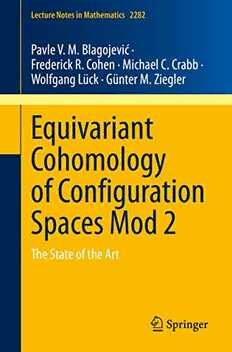Table Of ContentLecture Notes in Mathematics 2282
Pavle V. M. Blagojević
Frederick R. Cohen · Michael C. Crabb
Wolfgang Lück · Günter M. Ziegler
Equivariant
Cohomology
of Configuration
Spaces Mod 2
The State of the Art
Lecture Notes in Mathematics
Volume 2282
Editors-in-Chief
Jean-MichelMorel,CMLA,ENS,Cachan,France
BernardTeissier,IMJ-PRG,Paris,France
SeriesEditors
KarinBaur,UniversityofLeeds,Leeds,UK
MichelBrion,UGA,Grenoble,France
AlessioFigalli,ETHZurich,Zurich,Switzerland
AnnetteHuber,AlbertLudwigUniversity,Freiburg,Germany
DavarKhoshnevisan,TheUniversityofUtah,SaltLakeCity,UT,USA
IoannisKontoyiannis,UniversityofCambridge,Cambridge,UK
AngelaKunoth,UniversityofCologne,Cologne,Germany
LászlóSzékelyhidi ,InstituteofMathematics,LeipzigUniversity,
Leipzig,Germany
ArianeMézard,IMJ-PRG,Paris,France
MarkPodolskij,UniversityofLuxembourg,Esch-sur-Alzette,Luxembourg
SylviaSerfaty,NYUCourant,NewYork,NY,USA
GabrieleVezzosi,UniFI,Florence,Italy
AnnaWienhard,RuprechtKarlUniversity,Heidelberg,Germany
This series reports on new developments in all areas of mathematics and their
applications-quickly,informallyandatahighlevel.Mathematicaltextsanalysing
newdevelopmentsinmodellingandnumericalsimulationarewelcome.Thetypeof
materialconsideredforpublicationincludes:
1. Researchmonographs
2. Lecturesonanewfieldorpresentationsofanewangleinaclassicalfield
3. Summerschoolsandintensivecoursesontopicsofcurrentresearch.
Textswhichareoutofprintbutstillindemandmayalsobeconsiderediftheyfall
withinthesecategories.Thetimelinessofamanuscriptissometimesmoreimportant
thanitsform,whichmaybepreliminaryortentative.
Titles from this series are indexed by Scopus, Web of Science, Mathematical
Reviews,andzbMATH.
Moreinformationaboutthisseriesathttp://www.springer.com/series/304
Pavle V. M. Blagojevic´ (cid:129) Frederick R. Cohen (cid:129)
Michael C. Crabb (cid:129) Wolfgang Lück (cid:129)
Günter M. Ziegler
Equivariant Cohomology of
Configuration Spaces Mod 2
The State of the Art
PavleV.M.Blagojevic´ FrederickR.Cohen
InstituteofMathematics,FreieUniversität DepartmentofMathematics
Berlin UniversityofRochester
Berlin,Germany Rochester,NY,USA
MathematicalInstituteofSerbianAcademy
ofSciencesandArts
Belgrade,Serbia
MichaelC.Crabb WolfgangLück
InstituteofMathematics MathematischesInstitut
UniversityofAberdeen UniversitätBonn
Aberdeen,UK Bonn,Germany
GünterM.Ziegler
InstitutfürMathematik
FreieUniversitätBerlin
Berlin,Germany
ISSN0075-8434 ISSN1617-9692 (electronic)
LectureNotesinMathematics
ISBN978-3-030-84137-9 ISBN978-3-030-84138-6 (eBook)
https://doi.org/10.1007/978-3-030-84138-6
MathematicsSubjectClassification:55R80,55N25,57R22,57R42
©TheEditor(s)(ifapplicable)andTheAuthor(s),underexclusivelicensetoSpringerNatureSwitzerland
AG2021
Thisworkissubjecttocopyright.AllrightsaresolelyandexclusivelylicensedbythePublisher,whether
thewhole orpart ofthematerial isconcerned, specifically therights oftranslation, reprinting, reuse
ofillustrations, recitation, broadcasting, reproductiononmicrofilmsorinanyotherphysicalway,and
transmissionorinformationstorageandretrieval,electronicadaptation,computersoftware,orbysimilar
ordissimilarmethodologynowknownorhereafterdeveloped.
Theuseofgeneraldescriptivenames,registerednames,trademarks,servicemarks,etc.inthispublication
doesnotimply,evenintheabsenceofaspecificstatement,thatsuchnamesareexemptfromtherelevant
protectivelawsandregulationsandthereforefreeforgeneraluse.
Thepublisher,theauthors,andtheeditorsaresafetoassumethattheadviceandinformationinthisbook
arebelievedtobetrueandaccurateatthedateofpublication.Neitherthepublishernortheauthorsor
theeditorsgiveawarranty,expressedorimplied,withrespecttothematerialcontainedhereinorforany
errorsoromissionsthatmayhavebeenmade.Thepublisherremainsneutralwithregardtojurisdictional
claimsinpublishedmapsandinstitutionalaffiliations.
ThisSpringerimprintispublishedbytheregisteredcompanySpringerNatureSwitzerlandAG.
Theregisteredcompanyaddressis:Gewerbestrasse11,6330Cham,Switzerland
Thisbookisdedicatedto Aleksandra,Helen,
Sarah,Torsten,andVera
Preface
Thesystematicstudyoftheorderedconfigurationspace
F(M,n):={(x ,...,x )∈Mn :x (cid:3)=x forall1≤i <j ≤n}
1 n i j
of all ordered n-tuples of distinct points on a manifold M started in 1962 with
theworkofFadellandNeuwirth[47]andFoxandNeuwirth[52],withprehistory
going back to the work of Artin [7–9]. Soon after, Arnold, in his seminal work
[5] from 1969, gave a description of the integral cohomologyring of the ordered
configuration space F(R2,n). From that point on, the topology of the ordered
configurationspaceswasstudiedveryintensivelyfrommanyaspects,whilefinding
applicationsindiverseproblems,theories,andevendifferentfieldsofmathematics
andbeyond,notablyinphysics.
Each configurationspace F(M,n) is equippedwith a naturalfree action of the
symmetricgrouponnlettersS ,givenbythepermutationofpoints.Theassociated
n
orbitspaceF(M,n)/S ,calledtheunorderedconfigurationspace,isanimportant
n
andchallengingobjecttostudy.(Thefreeactionofthesymmetricgroupisalsoan
essentialingredientofthelittlecubesoperadstructuretobediscussedlater.)
In his influential 1970 paper [53] using fundamental new ideas, Fuks, gave
a description of the cohomology algebra of the unordered configuration space
H∗(F(R2,n)/S ;F )asanimageofthecohomologyH∗(BO(n);F ).Inthecourse
n 2 2
ofstudyofinfiniteanditeratedloopspaces,objectsofthesamehomotopytypeas
the configuration space F(Rd,n) were invented by Boardman and Vogt [17] and
adapted in a beautiful way by May [76, Sec.4] for the definition of an important
structure that we now call the little cubes operad; see Chap.7. Frederick Cohen,
in his1976contribution[33], gavethe first descriptionsof the cohomologyofthe
unorderedconfigurationspaceF(Rd,n)/S ,fornaprime,withtrivialcoefficients
n
(including the ring structure) and with twisted coefficients (includingthe relevant
modulestructure)[33,Thm.5.2andThm.5.3].
The homology of the unordered configuration space for points on a smooth
manifold M has been determined in 1989 by Bödigheimer et al. [20] in the case
when M is odd-dimensional and coefficients are in an arbitrary field, and in the
vii
viii Preface
casewhenM iseven-dimensionalandcoefficientsareinafieldofcharacteristic2.
More precisely, for even-dimensionalmanifolds, they computed the homology of
theunorderedconfigurationspaceofM withcoefficientsinthefieldtwistedbythe
signrepresentation.TheseresultsweregivenintermsofCohen’scomputationfor
thecaseM = Rn.Somefurtherresults,foraneven-dimensionalorientableclosed
manifoldand the rationals as the field of coefficients, were obtained by Félix and
Thomas[50].
NguyênHu˜’uViêt Hu’ng, in a series of papers [61–64] from 1981 until 1990,
studied the mod 2 cohomology algebra of the symmetric group S and of the
n
unorderedconfigurationspaceF(Rd,n)/S in thecase whennisa poweroftwo.
n
The key paper in this series, [64], which contained detailed proofs for all results
announcedin[62],wasapparentlyfinishedinAugustof1982,butaftersomedelays
(describedin [64, Footnote1 on p.286])was publishedonly in 1990.The central
ideawas
– Toconsideranaturalembedding
Pe(Rd,2m) ecyd,2m F(Rd,2m)
oftheproductofspheresPe(Rd,2m)=(Sd−1)2m−1intotheconfigurationspace
F(Rd,2m), which turns out to be equivariantwith respect to the action of the
Sylow2-subgroupS2m ofthesymmetricgroupS2m.
– To describe the cohomology ring H∗(Pe(Rd,2m)/S2m;F2) of the quotient
spacePe(Rd,2m)/S2m usingthehomeomorphism
(cid:2) (cid:3)
Pe(Rd,2m+1)/S2m+1 ∼= Pe(Rd,2m)/S2m ×Pe(Rd,2m)/S2m ×Z2 Sd−1
viaaninductivecomputation.
– Toprovethattheinducedhomomorphismincohomology
H∗(F(Rd,2m)/ 2m;F2) (id/ 2m)∗ H∗(F(Rd,2m)/S2m;F2)
(ecyd,2m/S2m)∗ H∗(Pe(Rd,2m)/S2m;F2)
isamonomorphism.Here(id/S2m)∗ isdirectlyamonomorphismsinceS2m is
aSylow2-subgroupofS2m andcohomologyisconsideredwithF2coefficients.
Thus,themaindifficultyliesinprovingthat(ecyd,2m/S2m)∗ isinjective.
In this way, the cohomology ring H∗(F(Rd,2m)/S2m;F2) of the unordered con-
figuration space F(Rd,2m)/S2m could be seen as a subring of the now-known
cohomologyringH∗(Pe(Rd,2m)/S2m;F2).
This series of papers, and in particular the paper [64], feature extended and
substantialcalculations.Itturnedouttobeimportantandinfluential.Itwasquoted,
and its main result was used, in quite a number of papers since then, such as
Preface ix
Vassiliev’s 1988 and 1998 papers on braid group cohomologies and algorithm
complexity [98] and r-neighborly embeddings of manifolds [100], Crabb’s 2012
survey on the topological Tverberg theorem and related topics [42], Karasev and
Landweber’s2012paperonhighertopologicalcomplexityofspheres[68],Karasev
and Volovikov’s 2013 paper on the waist of the sphere theorem for maps to
manifolds[69],Matschke’s2014paperonaparameterizedBorsuk–Ulam–Bourgin–
Yang–Volovikovpaper[74],aswellasKarasev,Hubard,andAronov’s2014paper
onthe“spicychickentheorem”[67].
Noneofthesepapersmentionedthefactthat—aswewilldocumentinSect.4.1
of the present work—Hu’ng’s proof for his main result [62, Thm.2.3] and [64,
Thm.3.1] is incorrect,as are some of his intermediateand follow-upresults. This
doesnotjeopardizethepaperslistedabove,asHu’ng’smainresult,theinjectivityof
thecomposition(ecyd,2m/S2m)∗◦(id/S2m)∗,holds,aswewilldemonstrate—bya
new,entirelydifferent,homotopy-theoreticproof—inSect.4.2ofthisbook.
Incontrasttotheaboveworks,the2016paperofBlagojevic´etal.[15]—bythree
of the present authors—did not only quote Hu’ng’s papers, but it also used some
of Hu’ng’s intermediate results in an essential way, specifically the decomposition
oftheequivariantcohomologyclaimedin[64,(4.7),page279].Ourcomputations
in [15] based on this led to results that are not consistent with some of Crabb’s
computationsrelatedto [42]. Thisled to our discoveryof the substantialmistakes
inHu’ng’spaper,includingthefactthatthedecompositionof[64,(4.7),p.279]is
notcorrect,whichalsoinvalidatesthemainresultsof[15]andtwominorfollow-up
corollariesgivenin[14].
Thus, the second main purpose of the present book is to correct our work in
[14]andin[15],bypresentingalternativearguments,basedonthecorrectedproof
forHu’ng’stheorem,towardsestimatesforthedimensionsofk-regularembeddings
andtheirrelatives.Theresultswegetareinsomecasesweakerthanwhatwe had
claimedbefore,inothercaseswerecreatethepreviouslyclaimedresultsinfull.
Thistextisorganizedasfollows.(Seebelowforasummaryofnotationsaswellas
fordefinitionsandbackground.)
– InChap.2wedescribetheS2m-equivariantembedding
ecyd,2m: Pe(Rd,2m) F(Rd,2m)
ofthe(d−1)(2m−1)-dimensionalmanifoldPe(Rd,2m)∼=(Sd−1)2m−1intothe
classicalconfigurationspaceF(Rd,2m).Furthermore,werelatetheembedding
ecy withthestructuralmapofthelittlecubesoperad.
d,2m
– In Chap.3 we study the S2m-equivariant cohomology HS∗2m(Pe(Rd,2m);F2)
usingtheSerrespectralsequenceassociatedtothefiberbundle
X×X (X×X)×Z2 EZ2 BZ2.
x Preface
Thehighlightofthatchapteristheproofofthedecompositionofthecohomol-
ogygiveninTheorem3.11:
H∗ (Pe(Rd,2m);F )
S2m 2
∼=F [V ,...,V ]/(cid:8)Vd ,...,Vd (cid:9)⊕I∗(Rd,2m),
2 m,1 m,m m,1 m,m
whereI∗(Rd,2m)isanideal,anddeg(V )=2r−1for1≤r ≤m.
m,r
– InChap.4wediscusstheclaimthattheinducedhomomorphismincohomology
(ecyd,2m/S2m)∗: H∗(F(Rd,2m)/S2m;F2) H∗(Pe(Rd,2m)/S2m;F2)
isamonomorphism,orequivalentlythatthehomomorphism
(ecyd,2m/S2m)∗◦(id/ 2m)∗: H∗(F(Rd,2m)/ 2m;F2)
H∗(Pe(Rd,2m)/S2m;F2)
is a monomorphism. In Sect.4.1 we present the proof for injectivity of
(ecyd,2m/S2m)∗ givenbyHu’ngin[64,Thm.3.1]anddocumentseveralcritical
gapsthat invalidate this proof.In particular, the failure of decomposition[64,
(4.7)]willbeillustratedbyacounterexampleinClaim4.5.Thenewinductive
proof of the injectivity of (ecyd,2m/S2m)∗, or (ecyd,2m/S2m)∗ ◦(id/S2m)∗, is
given in Sect.4.2. More precisely, for the inductive step, using the presen-
tation of homology of the configuration space via Araki–Kudo–Dyer–Lashof
homologyoperations,weprovethatthestructuralmapofthelittlecubesoperad
induces,nowinhomology,anepimorphism
(μd,2m)∗: H∗((Cd(2m−1)/ 2m−1 ×Cd(2m−1)/ 2m−1)×Z2 Cd(2);F2)
H∗(Cd(2m)/ 2m;F2);
seeTheorem4.8.
– Additionally in Sect.4.3, motivated by the results of Atiyah [10] and Giusti
et al. [55] we prove, as an interesting fact, that the homologyof the space of
allfinitesubsetsofRd withadditionofabasepointandappropriatelydefined
multiplicationisapolynomialring.
– In Chap.5, based on the results of the previous chapters, we explain the
induced gaps in the results given by three of the present authors in [15,
Thm.2.1, Thm.3.1, Thm.4.1] and [14, Thm.5.1, Thm.6.1] and correct all of
them. In particular, corrected lower bounds for the existence of k-regular, (cid:2)-
skew and k-regular-(cid:2)-skew embeddings of an Euclidean space are given; see
Theorems5.14,5.18,and5.22.

